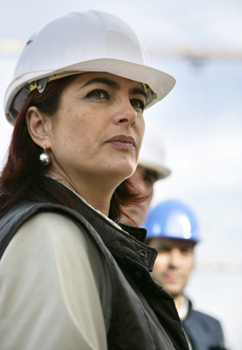ConstructConnect, ABI, Beige Book signal positive, but mixed, outlook for starts
 Editor’s note: Construction Citizen is proud to partner with AGC America to bring you AGC Chief Economist Ken Simonson's Data DIGest. Check back each week to get Ken's expert analysis of what's happening in our industry.
Editor’s note: Construction Citizen is proud to partner with AGC America to bring you AGC Chief Economist Ken Simonson's Data DIGest. Check back each week to get Ken's expert analysis of what's happening in our industry.
The value of nonresidential construction starts decreased 5.6%, not seasonally adjusted, year-over-year (y/y) from December 2015 to December 2016 but increased 6.8% for the full year, data provider ConstructConnect reported on Tuesday. Nonresidential building starts (66% of the total) slipped 2.3% y/y but expanded by 11% for the full year. Commercial building starts dipped 1.7% y/y but added 11% for the year; institutional building starts, -3.9% y/y and +12% for the year; and the small industrial building starts segment, +0.3% y/y and -13% for the year. Heavy engineering (civil) starts (34% of the total) fell 12% y/y but only 0.5% for the year. The largest subsegments, in descending order of 2016 size, were school/college, down 9.7% for the year; road/highway, up 1.6%; water/sewage, up 6.8%; and retail/shopping, up 25%.
The Architecture Billings Index (ABI) score in December soared to 55.9, seasonally adjusted, the highest one-month reading since July 2007, and a large leap from November's mark of 50.6, the American Institute of Architects reported on Wednesday. The ABI measures the percentage of surveyed architecture firms that reported higher billings than a month earlier less the percentage reporting lower billings; any score over 50 indicates billings growth. The institute says the index "reflects the approximate 9-to-12 month lead time between architecture billings and construction spending." For the second month in a row, scores exceeded 50 for firms with all practice specialties (based on three-month moving averages): commercial/industrial, 54.3, up from 52.9 in November; institutional, 53.3, up from 51.8; mixed practice, 51.9, up slightly from 51.8; and. multifamily residential, 50.6, down from 51.9.
"Reports from the 12 Federal Reserve districts indicated that the economy continued to expand at a modest pace across most regions from late November through the end of the year," the Fed reported on Wednesday in a revised format of the "Beige Book" (named for color of its cover), a summary of informal soundings of businesses in each district. "Cost increases were reported for [selected building] materials." Construction-related comments from each district (which the Fed names for its headquarters city) follow. Boston: Apartment construction activity slowed in recent months in both Boston and Portland, while office construction was stable at a slow pace in Boston and minimal in the rest of the region. New York: Residential construction was sluggish, while there has been some pickup in office and especially industrial construction. Philadelphia: Nonresidential real estate contacts covering much of the [district] reported that slow, steady incremental growth was supporting leasing (and pre-leasing) activity, falling vacancy rates, rising rents, and new construction. Cleveland: Residential and commercial construction activity remains elevated. Richmond: Stronger multi-family construction was reported in Washington, D.C., Charlotte, [N.C.], and Charleston, [S.C.]. Atlanta: The majority of commercial contractors indicated that the pace of nonresidential construction activity had increased from one year ago, with many reporting backlogs greater than one year. Chicago: construction and real estate activity edged up. St. Louis: Commercial construction activity improved moderately. Minneapolis: Commercial construction held steady at high levels, but heavy and residential construction lagged. Kansas City: Contacts in the commercial real estate sector reported similar conditions since the previous survey period as absorption and completions increased slightly, but construction underway, sales, vacancy rates and prices were flat. Dallas: Contacts noted that financing for new multifamily properties has become more difficult to obtain. San Francisco: Demand for new commercial construction strengthened, and one contact noted that activity in the Sacramento area remained robust.
Housing starts, an often volatile number, rebounded by 11% in December at a seasonally adjusted annual rate after plunging 17% in November, the Census Bureau reported today. Starts increased 4.9% for all of 2016 compared to the 2015 total. Single-family starts slumped 4.0% for the month but increased 9.3% for the year. Multifamily (buildings with 5 or more units) starts soared 54% for the month, after tumbling 39% in November, and declined 3.1% for the year. Building permits, a fairly reliable predictor over time of near-term starts, were nearly flat for the month (-0.2%) and full year (+0.4%). Single-family permits increased 4.7% for the month and 7.1% for the year. Multifamily permits retreated 10% for the month and year. Multifamily permits for the year (407,000) exceeded starts (374,000), suggesting there are still unbuilt projects with permits. But the downturn in both series in 2016 implies that the growth rate for multifamily construction spending is likely to slow in 2017 and possibly turn negative by 2018. Multifamily spending in the first 11 months of 2016 combined was 17% above the total for the first 11 months of 2015, Census reported on January 3.
Inflation-adjusted gross domestic product (real GDP) by industry estimates released by the Bureau of Economic Analysis today show that "20 of 22 industry groups contributed to the overall 3.5% increase in real GDP in the third quarter" of 2016 (Q3), at a seasonally adjusted annual rate.Real GDP in construction increased 0.8%, after decreasing 3.7% in Q2. The industry's share of GDP held steady at 4.2% ($785 billion out of $18.675 trillion). "Real gross output—principally a measure of an industry's sales or receipts, which includes sales to final users in the economy (GDP) and sales to other industries (intermediate inputs)—increased in [Q3] in 19 of 22 industry groups." Output in construction totaled $1.428 trillion in Q3, a decline from Q2 of 0.6%.
The Data DIGest is a weekly summary of economic news; items most relevant to construction are in italics. All rights reserved. Sign up at www.agc.org/datadigest.


